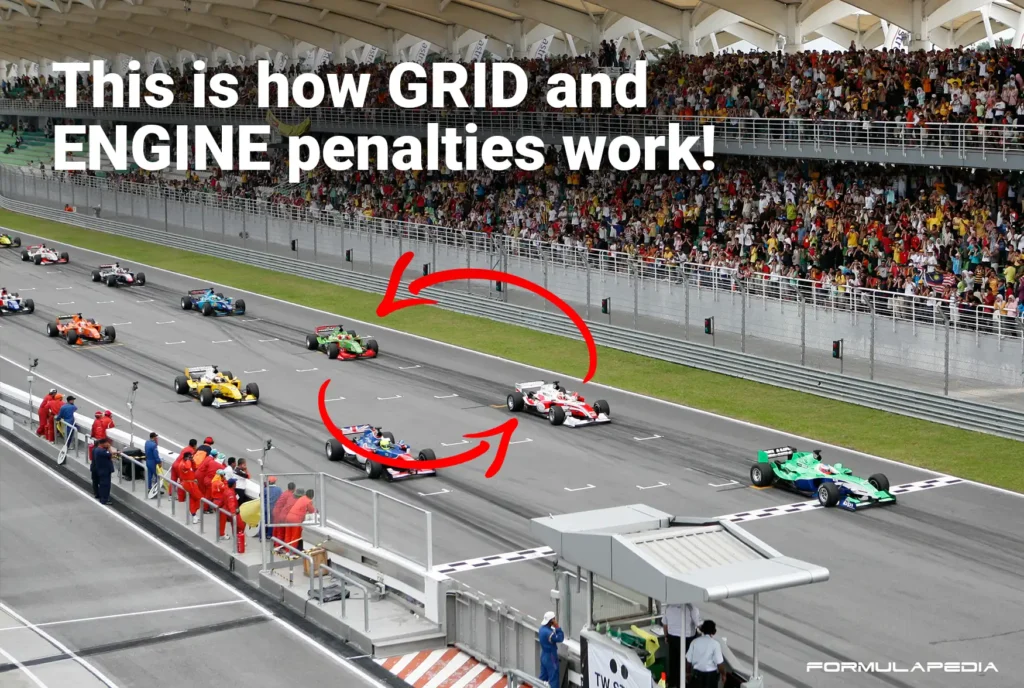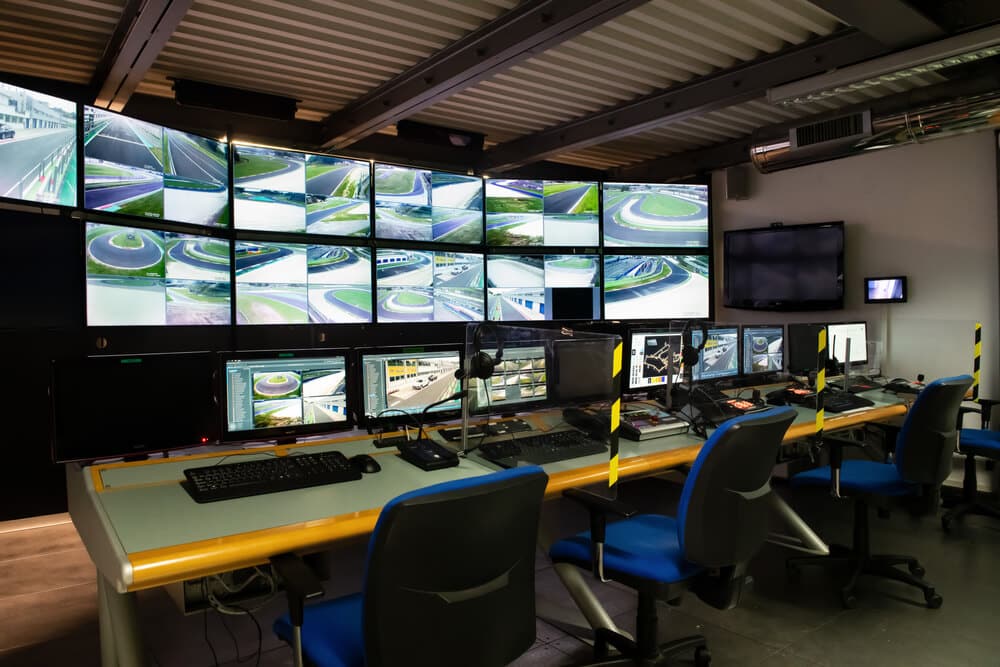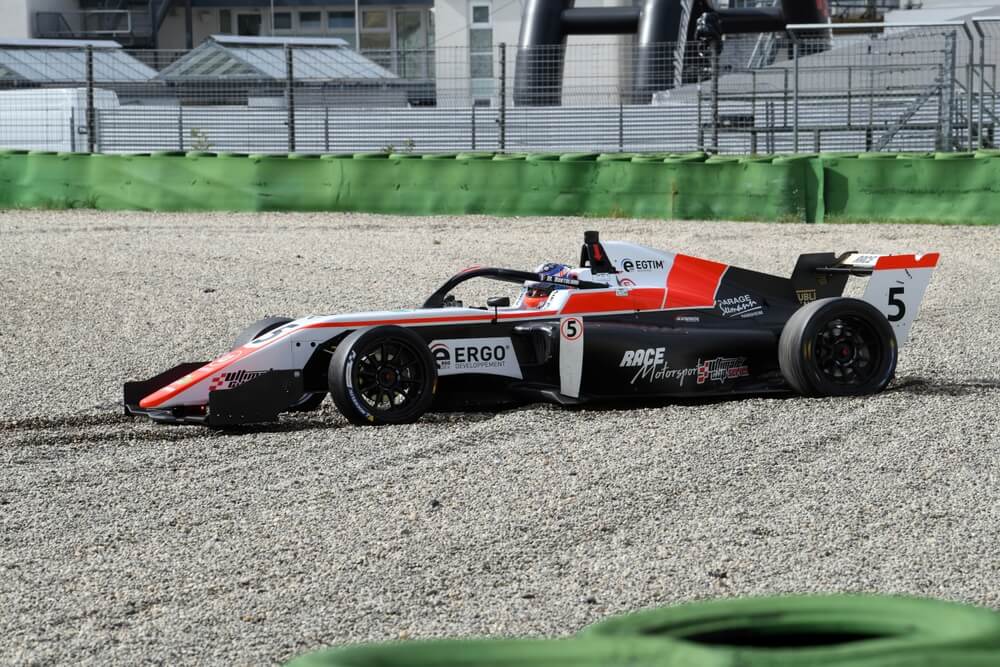It can not be an exciting F1 motorsport event until a driver gets a penalty. While there are no obligations on a driver to commit one, difficult situations during the race make some drivers eventually get to it.
One of the several penalties is the Engine penalty. Each driver is allocated a limited number of components for their vehicle. 3 components of the Internal combustion engine are allotted to the driver.
Once the driver has used up more than the maximum number of parts on their vehicle, regardless of the cause, they will receive a penalty. This is not only limited to the engine but other parts of the vehicle as well, such as the exhaust and turbocharger.
Table of Contents
Watch this video to understand how grid penalties and engine penalties work.
What are F1 grid penalties?
A Formula 1 driver can be hit with a grid penalty when he has broken engine regulations. Grid penalties mean that you have to start further back on the grid at the start of the race. The penalty is also called an engine penalty because it comes from breaking the engine regulations.
Key takeaways
- There are three kinds of grid penalties: 3-place, 5-place, and 10-place.
- There are no defined criteria for penalties.
- The penalty is decided upon by judging the severity of the violation.

How are grid penalties applied in Formula 1?
Once the violation of the rule is clear, the FIA hands out one of the three levels of penalty to the driver. The levels for the penalties are defined according to the depth of the act. There are several kinds of penalties for various violations.
The grid penalties determine the position of the driver in the next race. The new positions are imposed with the penalty and are decided through their qualifying position in the current race.
3-place grid penalty
A 3-place grid penalty is the least of the rest. It is often given on less serious or smaller acts that violate the rules. For example, a collision with another driver may result in a 3-place grid penalty.
While this may seem less for such an act, there always isn’t a very pre-defined scenario for handing out these penalties.
It is checked and decided according to the rulebooks and examining the previous act of breaches of a particular driver.
5-place grid penalty
A 5-place grid penalty comes after the previous one, which is given on a higher degree of violation. For example, exceeding the component limit by not using the same gearbox for four consecutive races.
Upon receiving it, a driver will now be placed in the sixth position if they qualified for the first in the current race.
10-place grid penalty
A 10-place grid penalty is given upon a severe action that is committed by a driver.
It is also the first penalty to be handed over on the use of the first additional component. Later, it goes down to the 5-place grid penalty in the second use.
Furthermore, putting another driver’s life at risk makes way for a 10-place grid penalty or even a ban from the championship.
When can an F1 driver receive a grid penalty?
Here are the most common examples of when an F1 driver is hit with grid penalties.
When the driver causes a collision
Colliding with another vehicle results in the driver getting a penalty. During the race, the vehicles spotted to have been in a collision are put under investigation. The investigation leads to finding out the guilty of the cause that is to be given a penalty. The driver found guilty is usually given a 10-second penalty. This penalty bounds them to stop for 10 seconds in their pit and then carry on with the rest of the race.
However, if a driver chooses not to do so, the penalty time is then added to their race completion time.
When the driver drives dangerous
Driving dangerously and putting other lives at risk is considered a great violation of the F1 rules and regulations. Although there are no certain criteria set out for penalizing the driver for such an act. The Stewards may decide to fine or give the 10-place grid penalty to the driver.
The Stewards may also choose a ten-second stop-and-go penalty where the driver must stop for at least 10 seconds before they can rejoin the race. However, do note that no work is to be done to the vehicle during the pit stop.
The Stewards may also choose a ten-second stop-and-go penalty where the driver must stop for at least 10 seconds before they can rejoin the race. However, do note that no work is to be done to the vehicle during the pit stop.
Exceeding reprimand threshold
Receiving a hefty amount of penalties may get minor penalties upgraded to strict ones. At times they may also be finalized as a 10-place grid penalty once a limit of violations has been exceeded.
In addition to that, a driver receives a penalty point whenever they violate the rule.
Once a driver exceeds 12 points under a course of one year, they will have to face a one-race ban. However, the penalty point punishment is not very common but might become one if it is often given on a very minor violation.
When a driver prevents another driver
Blocking another vehicle from getting ahead may seem justified. However, there are guidelines to be followed that restrict drivers from dangerously overtaking and blocking other drivers from passing them.
Any vehicle that goes off the race track and then rejoins the fast track violates this rule. Therefore, the driver will be forced to drive along the corners, slowing down the vehicle for violating the rule.
F1 motorsports are very strict when it comes to exceeding the component limits. The number of components that are allowed for each vehicle is already stated, such as 3 turbochargers, 8 exhausts, 4 gearboxes, etc.
Exceeding component limits
F1 motorsports are very strict when it comes to exceeding the component limits. The number of components that are allowed for each vehicle is already stated, such as 3 turbochargers, 8 exhausts, 4 gearboxes, etc.
If, in any case, these numbers are exceeded, the ruling team imposes a 10-place grid penalty on the first violation, followed by the 5-place grid penalty.
However, this rule might not be taken into consideration when a vehicle is in dire need of parts replacement. Although, the driver would have to bear the loss of going back several positions in the next race.
Changing gearboxes
Needing to change the gearbox can be essential in such a hectic race. However, it also comes with a pre-defined number that is limited to 4 components for each gearbox part. If a driver is found to be violating this rule by exceeding or swapping the gearbox components, they receive a 10-place grid penalty.
Furthermore, as mentioned earlier, the driver must use the same gearbox for four consecutive races before they can swap it out. However, if FIA allows, gearboxes can be repaired without violating any rule, although it isn’t allowed in all cases.
A driver will get a grid penalty if he changes parts of the F1 cars engine during a weekend.
There are tactics behind different penalties
No driver would like to have a penalty point stuck to their profile. Therefore, simply preventing the causes of the penalties that are mentioned above can let a driver qualify without losing their position in the next race.
However, it is not the same case every time. Drivers can’t help but get a penalty for crashing into each other, which usually happens unintentionally.
Although, in cases where you get a penalty for unfair usage of mechanical parts, the Stewards hand out the penalty justifiably.
Frequently asked questions
What is the penalty for changing the engine in F1?
How is a driver affected by a grid penalty?
Conclusion
By now, you would be knowledgeable enough about F1 motorsports that would let you develop an interest in the game if you did not have it previously.
Moreover, you would be able to call out and decide for yourself upon witnessing a violation of the rule and judge whether the player you’re supporting deserved that penalty.
Learn more about Formula One
Want to learn more about F1? Then visit our Formula 1 glossary and dictionary.




